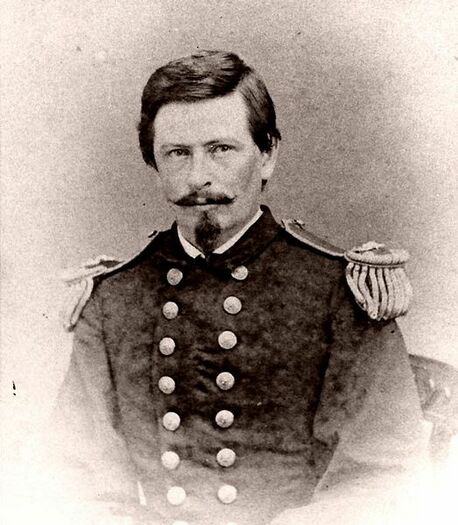ALEXANDER S. MACKENZIE, LCDR, USN
Alexander MacKenzie '59
Alexander Slidell MacKenzie was admitted to the Naval Academy from New Jersey on September 28, 1855 at age 13 years 9 months.
Loss
Alexander was killed in action with the Paiwan, an indigenous Taiwanese tribe, on June 13, 1867 during an a expedition to retaliate for an attack on an American ship in March.
Other Information
From researcher Kathy Franz:
In the below news article, Admiral Bell indicates Alexander was buried on the British Consulate at Takao. This is now a historic site in the Gushan District, Kaohsiung, Taiwan.
Alexander's father was a Navy officer who executed three mutineers from USS Somers in 1842. He was the brother of John Slidell who was involved in the Civil War's “Trent Affair.”
Alexander's brother Ranald was a West Point graduate, fought in the Civil War, and became “the best Indian fighter” in the 4th Cavalry Regiment. When Quanah Parker of the Comanche Tribe surrendered, Ranald and Quanah became good friends. His other brother Morris (Class of 1866) became a Navy admiral.
Alexander's sisters were Harriet and Mary. Harriet never married and died in 1906. Mary died at age 10 in 1856. Alexander's aunt Jane married Commodore Matthew C. Perry.
From the New York Daily Herald, August 24, 1867:
Report of Admiral Bell, United States Flagship Hartford, Shanghai, China, June 19, 1867.
To: Hon. Gideon Welles, Secretary of the Navy. . . The landing [on the southern extremity of the island of Formosa] of one hundred and eight-one officers, sailors and marines, provided with four day's rations and water, was made at half-past nine o'clock, under the command of Commander G. E. Belknap, of the Hartford, accompanied by Lieutenant Commander Alexander S. Mackenzie, Fleet Lieutenant, as second in command, who earnestly sought to go on the expedition. Soon after we anchored the savages, dressed in clouts and their bodies painted red, were seen through our glasses assembling in parties of ten or twelve on the cleared hills about two miles distant. . . As our men marched into the hills, the savages, knowing the paths, boldly decided to meet them, and, gliding through the high grass and from cover to cover, displayed a strategy and courage equal to our native Indians. Delivering their fire, they retreated without being seen by our men, who, charging upon their covers, frequently fell into ambush.
Our detachments pursued them in this harassing manner out of sight of the ships until two o'clock P. M., when having halted to rest, the savages took the opportunity to creep up and fired upon the party commanded by Lieutenant Commander Mackenzie, and that officer, placing himself at the head of the company commanded by Lieutenant Sands, daringly led a charge into the ambuscade that was laid for them, and fell mortally wounded by a musket ball and died while being carried to the rear. The navy could boast of no braver spirit and no man of higher promise than Lieutenant Commander Alexander S. Mackenzie. He was distinguished for professional knowledge, aptitude and tact and suavity of manners which inspired the confidence and affection of the men, while his impetuous courage impelled him along to seek the post of danger where he was always seen in the advance, both a conspicuous mark and an example. . .
The British Consul at Takao Formosa, Acting Consul Charles Carroll, and Messrs. Taylor and Pickering, English subjects, residing at that place, accompanied the expedition as volunteers and rendered good service, being generally at the front. Mr. Taylor went to the assistance of Lieutenant Commander Mackenzie when the cry of “A wounded man” was heard . . .
That solitary grave in the grounds of the British Consulate at Takao speaks a language more eloquent and touching than human utterance can express. No one knew the worth, the high toned character and professional ability of the deceased better than yourself, and I but give expression to the general feeling when I add that in him the service lost one of its brightest ornaments and the country one of its most zealous and gallant defenders.
From Charles H. Page, Assistant Surgeon's report: I found Mr. Mackenzie falling, with his left hand on his right breast. I caught him by the coat collar and asked him where he was wounded, at the same time, with what aid I could procure, dragging him to the rear as rapidly as possible. In reply he looked up at me, moved his hand on his breast a little higher, and only said, “Page – Page – Page – I'm dead!” and ceased to live at about half-past two o'clock P.M. and about three or four minutes from the time he was wounded. The wound was round and smooth, of about an inch in diameter, penetrating deeply the upper anterior and middle portion of the right chest, just below the collar bone, with no external hemorrhage of importance.
Other Naval Academy officers who went on this expedition were: Lieutenant Commander J. H. Reed (Class of 1863), Lieutenant J. H. Sands (Class of 1864), and Lieutenant G. D. B. Glidden (Class of 1864).
From the Naval History and Heritage Command:
Alexander Slidell MacKenzie was born in New York on 24 January 1842, the son of a Navy Commander of the same name. Appointed to the U.S. Naval Academy in 1855, he graduated in June 1859 and was assigned to the newly-completed steam sloop of war Hartford. During the next two years, Midshipman MacKenzie served in that ship with the East India Squadron. Promoted to Lieutenant in August 1861, he was an officer of the gunboat Kineo during the conquest of the lower Mississippi River in 1862. Later transferred to the South Atlantic Blockading Squadron, MacKenzie served off Charleston, South Carolina, in the steam frigate Wabash and monitor Patapsco, taking part in combat operations against Fort Sumter and Morris Island. Later in the Civil War he commanded the gunboat Winona, also in the waters off South Carolina. In July 1865 MacKenzie received the rank of Lieutenant Commander and soon began a second Far Eastern deployment in USS Hartford. He was killed in action on 13 June 1867, during a punitive expedition ashore in southern Formosa.
He is listed on the killed in action panel in the front of Memorial Hall under the heading "Formosa Expedition 1867." Alexander's Find A Grave page is here.
Career
From the Naval History and Heritage Command:
Acting Midshipman, 29 September, 1855. Midshipman, 9 June, 1859. Lieutenant, 31 August, 1861. Lieutenant Commander, 29 July, 1865. Killed in battle 13 June, 1867.
From the August 1962 issue of Shipmate; the article is a much longer one on Alexander's father:
Alexander Slidell Mackenzie, Jr. graduated from the Naval Academy in 1859 (graduate no. 370) in the same class as Mahan. His first cruise was in the Hartford, flagship of the East Indian Squadron. In the papers of S.F. DuPont in the Eleutherian Mills Historical Library, Wilmington, Delaware, there is a letter from his widowed mother asking her friend. Captain Du Pont, for the itinerary of the Hartford ordered home in 1861. She wanted to get letters to her son to counteract the secession sentiment she feared was rampant in the wardroom and steerage of the ship. Her fears were unfounded. The Hartford and Mackenzie arrived home in time to take part in the battle of New Orleans. He was in the ironclad New Ironsides in the attack on Fort Sumter, 7 April 1863. He did a tour as instructor in seamanship at the Naval Academy in Newport and then became executive of the Hartford. He was killed in action 13 June 1867 on the island of Taiwan while in command of a force that had gone ashore to punish savages for the murder of members of the crew of an American whaling ship. The tribute he received from his commander, Rear Admiral H. H. Bell, was perhaps even great than that given his brother. "The Navy could boast no braver spirit, no man of higher promise."
Namesakes
USS MacKenzie (Torpedo Boat No. 17), USS MacKenzie (DD 175), and USS MacKenzie (DD 614) were all named for him.
The "Register of Commissioned and Warrant Officers of the United States Navy and Marine Corps" was published annually from 1815 through at least the 1970s; it provided rank, command or station, and occasionally billet until the beginning of World War II when command/station was no longer included. Scanned copies were reviewed and data entered from the mid-1840s through 1922, when more-frequent Navy Directories were available.
The Navy Directory was a publication that provided information on the command, billet, and rank of every active and retired naval officer. Single editions have been found online from January 1915 and March 1918, and then from three to six editions per year from 1923 through 1940; the final edition is from April 1941.
The entries in both series of documents are sometimes cryptic and confusing. They are often inconsistent, even within an edition, with the name of commands; this is especially true for aviation squadrons in the 1920s and early 1930s.
Alumni listed at the same command may or may not have had significant interactions; they could have shared a stateroom or workspace, stood many hours of watch together… or, especially at the larger commands, they might not have known each other at all. The information provides the opportunity to draw connections that are otherwise invisible, though, and gives a fuller view of the professional experiences of these alumni in Memorial Hall.
January 1856
January 1857
January 1858
January 1860
September 1861
September 1862
January 1863
January 1864

The "category" links below lead to lists of related Honorees; use them to explore further the service and sacrifice of alumni in Memorial Hall.
